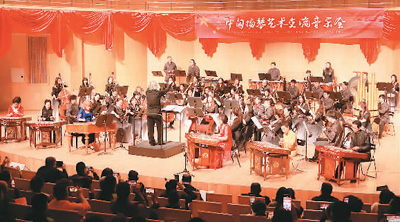In the spring, the familiar Chinese masterpiece Jasmine Flower and the Hungarian masterpiece Tsardas Dance rang out in the concert hall of Guoyin Hall of the China Conservatory of Music. On the stage, the melodious tones of the Chinese yangqin and the gentle and deep tones of the Hungarian cimbalom mingled with each other, giving these two classic pieces a new charm. In the warm applause of the audience, the Hungarian yangqin player, President of the World Association of the Yangqin, Herensa, and the Chinese yangqin player, President of the Yangqin Specialized Committee of the Chinese Society of Folk Orchestral Music, Vice President of the World Association of the Yangqin, Li Lingling, walked to the front of the stage hand in hand to pay homage to the audience. At this moment, the yangqin tightly linked the two artists, two peoples and two countries from the East and the West.
Yangqin is an instrument that is both universal and national. The Chinese yangqin belongs to the great family of the yangqin, together with the Hungarian cymbalon and other such instruments around the world, which are rooted in different cultural soils and have evolved into national musical instruments of which the people of each country are proud.
In 1991, the World Yangqin Association was registered in Hungary and the first World Yangqin Conference was successfully held. Prof. Xiang Zuhua, the first generation of yangqin artists in New China, and his disciple, Li Lingling, a professor of yangqin at the China Conservatory of Music, were invited to participate in the conference as the founding members of the World Yangqin Association. At the conference, Mr. Xiang Zuhua was elected as the vice president of the World Yangqin Association and put forward the idea of dividing the world's yangqin into three major systems, namely, “European yangqin, West-South Asian yangqin and Chinese yangqin”. This conference not only established the important position of Chinese yangqin in the world's yangqin family, but also opened a new era of Sino-Hungarian yangqin art exchange.
From the 8th World Yangqin Congress in 2005, to the 12th World Yangqin Congress in 2013, to the 15th World Yangqin Congress in 2019, the success of each World Yangqin Congress in China cannot be separated from the strong support of the Hungarian yangqin artists. Over the past 30 years, artists from China and Hungary have exchanged ideas and visits, and deepened their artistic understanding of each other through cooperation in the form of concerts, masterclasses and musical creations. For more than 30 years, Chinese and Hungarian artists have exchanged and visited each other and deepened their artistic understanding through concerts, master classes, music creation and other forms of cooperation. Under the joint efforts of the artists of both countries, the Chinese and Hungarian yangqin art exchanges have gradually matured and stabilized, and have become a bright landscape in the cultural exchanges between the two countries, composing a new melody for the mutual appreciation of the civilizations of the two countries and the inheritance of friendship.
This year, a series of yangqin art exchange activities have been centrally carried out: the “Night of the Yangqin” China-Hungary yangqin exchange recital held at the Hungarian Cultural Center in Beijing, the Hungarian yangqin masterclasses, lectures and “China-Hungary yangqin art exchange concert” held in the China Conservatory of Music, the 20th China International Wine Expo was held in Luzhou, Sichuan Province, the opening ceremony of the Hungarian Pavilion held in Luzhou, Sichuan Province, as well as the Rhythm of the Yangqin——China-Hungary Friendship concert created by the Chongqing National Orchestra, etc. During this period, the Chinese and Hungarian yangqin artists together contributed many wonderful performances, which demonstrated the deep friendship between the artists of the two countries and the results of long-term exchanges and cooperation.
As the representative of Chinese yangqin artists, Li Lingling was invited to participate in the above activities, she said, “This year is the 75th anniversary of the establishment of diplomatic relations between China and Hungary, and the 60th anniversary of the founding of the China Conservatory of Music, in this special year, the teachers and students of the yangqin program of the China Conservatory of Music will carry out more exchanges and activities to fully demonstrate the unique charms of the Chinese yangqin art. At the same time, Chinese yangqin artists will continue to promote exchanges between China and Hungary and other countries in the field of yangqin, and use music as a medium to help international humanistic cooperation.”
